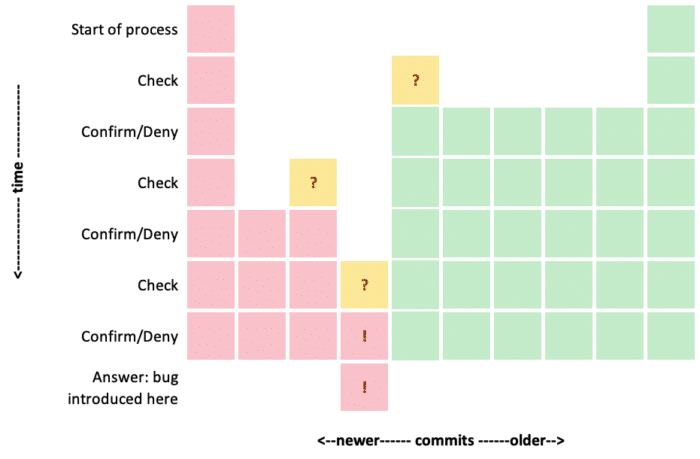During some recent work on Maven, I found a very specific bug. The error message wasn't that clear, and I couldn't make a guess what might've caused it.
I had read about git bisect a few times and figured that this time, I would use that tool to find the bug.
So what does git bisect do? It helps you find the exact commit that introduced a bug, using binary search.
Prerequisites
For this, you must know a point in history (a commit hash, a tag) that did not have the bug. You also need to know a point in history that does have the bug. And finally, you need to have a reliable way to determine if the bug is there.
The Process
From here on, using git bisect looks a bit like a game:
Git: does this version of your project contain the bug?
Me runs some tests
Me: er, nope.
Git checks out another revision of the project
Git: how about now?
Me runs some tests
Me: yes!
And so on, so forth...
You start the "game" by telling the tool the "good" and the "bad" point that you know:
git bisect start git bisect bad # no argument, so current revision git bisect good cecedd34 # could also be a tag
Every time you answer that question, git bisect can cross out either half of the history between the last two points that you've checked:
git bisect good # this commit is fine, it doesn't have the bug git bisect bad # this commit is bad, it does have the bug git bisect skip # this commit cannot be tested for the bug
After each question that you answer, git checks out another revision, somewhere halfway between the last "good" and the last "bad" commit. With every iteration, this reduces the search space (the number of commits to consider) with 50%.

As you can see in the picture above, every time you answer that question, you get closer to knowing exactly which commit introduced the bug. Eventually, the game is over: git tells you the exact commit that introduced the bug:
9f88494b6064ad45ea2e2e1e3478afc7af0bc065 is the first bad commit
If you want, you can watch a replay by looking at the output of git bisect log. Now is also a good time to clean up the mess we made with all those checkouts by issuing git bisect reset.
Automate Everything!
But wait a minute... having this tedious manual check is both boring and error prone. There must be a way to automate this!
Of course, there is.
Rather than going through the manual process, we can have a script perform the check for us. Such a script must use the exit code to signal whether that revision is good or bad:
- If the script exits with code
0, it says "the bug is not present". - If the script exits with code
125, it says "can't say whether the bug is present". - If it exits with any other value between
1and127, it says "the bug is present".
Typically, something like mvn test would be a good test.
When Things Get Complicated
But what if your setup is a bit more complex? The situation I faced today was a problem where Maven couldn't build Maven. How would you use git bisect for that?
I've made a script that first builds the selected Git revision of Maven. Since the bug is in Maven, I need to build Maven before I can say if the bug is there. But the sample project is also Maven, so I got myself a second clone of the Git repo to test on.
The script looks like this:
# This is the Maven source clone that I # use to run bisect. export MAVENCODEBASE="/Users/maarten/Code/open-source/maven/maven" # If there's a compilation failure or what not, # we can't say whether this revision has the bug. mvn clean verify -f "$MAVENCODEBASE" -DskipTests=true || exit 125 # Make a temporary directory and unpack the # fresh Maven build there. tmp_dir=$(mktemp -d) pushd $tmp_dir # We don't need the maven-wrapper zip if it's there. rm $MAVENCODEBASE/apache-maven/target/*wrapper* || true unzip $MAVENCODEBASE/apache-maven/target/apache-maven-*.zip # Make sure the path is predictable # even when the version number changed between # the "good" and the "bad" commit mv apache-maven-* apache-maven # Just to be sure, see if the mvn executable works $tmp_dir/apache-maven/bin/mvn --version # Navigate to the second Maven project checkout # and use the fresh Maven build to build it. pushd /Users/maarten/Junk/git-bisect/maven $tmp_dir/apache-maven/bin/mvn validate # Remember whether it failed or not status=$? # Clean up after ourselves popd popd echo Removing $tmp_dir rm -Rf $tmp_dir # Tell git bisect about the quality of this build. echo "Exiting with status '$status'" exit $status
Since the bug was not present in the last release of Maven, the last "good" commit is the maven-3.6.3 tag. And because I don't know when it started failing, I use HEAD for the first "bad" commit.
git bisect start HEAD maven-3.6.3 -- git bisect run ../can-build-master.sh
After a couple of minutes and a lot of noise from my computer, I get the same output:
9f88494b6064ad45ea2e2e1e3478afc7af0bc065 is the first bad commit
Again, make sure to reset the project clone to a pristine state with git bisect reset.
Wrapping Up
So, did I find the bug? Well, yes and no. I did find out which commit introduced the bug. But given that the message was so unclear, I gave up there.
It was a useful journey nevertheless. At least I could file an issue, referencing that particular commit. That should make it easier for others as well to investigate what the actual problem is.